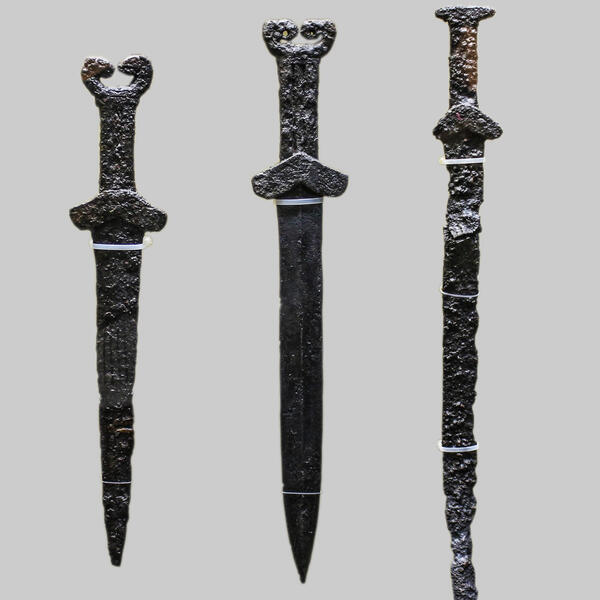The permanent exhibition of the State Museum of the South Ural History features two daggers. One of them was found in a destroyed burial mound near the village of Kotlik, in the Plastovsky District of the Chelyabinsk Region, and the other was discovered while plowing a field near the village of Dolgoderevenskoye.
The pommel of the dagger from the burial mound near Kotlik is separated from the handle by a narrow, embossed strip and is shaped like a pair of opposed eared griffin heads with sharply downturned beaks. The ears protrude slightly from the head. The hilt is short, ribbed, with three ridges on one side and two on the other, separated by a wide groove. The dagger’s crossguard resembles a butterfly. The blade’s edges are parallel and gradually taper towards the point.
The second dagger, which was found in the village of Dolgoderevenskoye, also has a butterfly-shaped crossguard. Its pommel looks like opposed feline heads. The blade is double-edged, with a diamond cross-section. It gradually tapers towards the point. The central part of the hilt features two parallel grooves with a snake between them. The pommel strip is decorated with multidirectional oblique incisions. The dagger is made of a solid piece of material, except for the welded crossguard.
Experts believe these daggers to be of SarmAtian origin. Such weapons first appeared in the 7th century BC and became especially popular in the 6th–4th century BC. They were widely used by the SarmAtians, a confederation of Iranian-speaking nomads. Warriors mainly used daggers to for jabs in close combat, but sometimes also for slashing blows.
A dagger is a stabbing hand-to-hand combat weapon with a double-edged blade. Scientists call short, 40–60 cm long swords ‘acinaces’. Blades longer than 60 cm are considered swords, and those shorter than 40 cm are considered daggers. According to this classification, the blades from the collection of the State Museum of the South Ural History fall under the dagger category.
Such daggers were worn in scabbards on the left side of the body or fastened to a leg with straps. The latter is confirmed by the copper warrior figurines from the Sapogovo hoard.
The pommel of the dagger from the burial mound near Kotlik is separated from the handle by a narrow, embossed strip and is shaped like a pair of opposed eared griffin heads with sharply downturned beaks. The ears protrude slightly from the head. The hilt is short, ribbed, with three ridges on one side and two on the other, separated by a wide groove. The dagger’s crossguard resembles a butterfly. The blade’s edges are parallel and gradually taper towards the point.
The second dagger, which was found in the village of Dolgoderevenskoye, also has a butterfly-shaped crossguard. Its pommel looks like opposed feline heads. The blade is double-edged, with a diamond cross-section. It gradually tapers towards the point. The central part of the hilt features two parallel grooves with a snake between them. The pommel strip is decorated with multidirectional oblique incisions. The dagger is made of a solid piece of material, except for the welded crossguard.
Experts believe these daggers to be of SarmAtian origin. Such weapons first appeared in the 7th century BC and became especially popular in the 6th–4th century BC. They were widely used by the SarmAtians, a confederation of Iranian-speaking nomads. Warriors mainly used daggers to for jabs in close combat, but sometimes also for slashing blows.
A dagger is a stabbing hand-to-hand combat weapon with a double-edged blade. Scientists call short, 40–60 cm long swords ‘acinaces’. Blades longer than 60 cm are considered swords, and those shorter than 40 cm are considered daggers. According to this classification, the blades from the collection of the State Museum of the South Ural History fall under the dagger category.
Such daggers were worn in scabbards on the left side of the body or fastened to a leg with straps. The latter is confirmed by the copper warrior figurines from the Sapogovo hoard.



